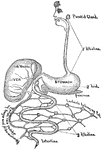Clipart tagged: ‘Digestive Tract’

Digestive Tract
This is a diagram of the digestive tract. Notice how the food is submitted to the action of alkaline,…

Stomach
The digestive system. This figure represents the whole tract of the intestinal canal, not exactly in…